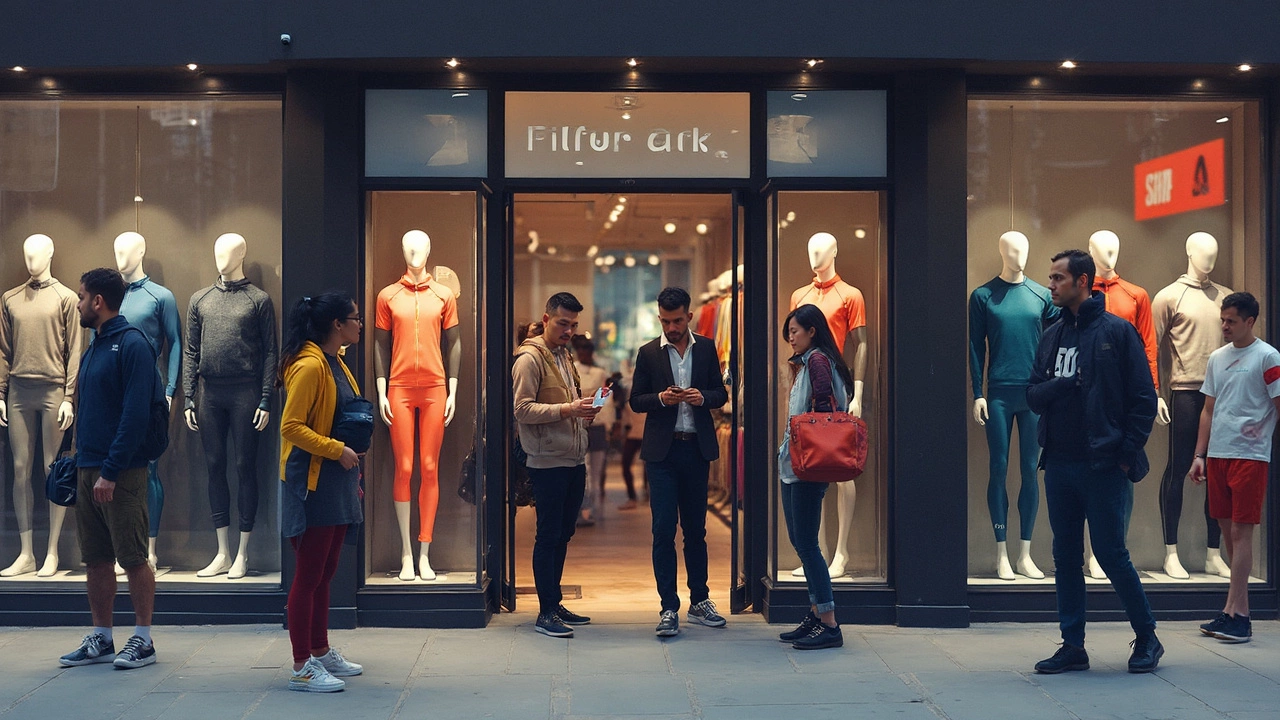Ever wonder why a pair of leggings or a workout shirt can cost as much as a nice dinner out? If you've noticed that sportswear prices are often through the roof, you're not alone. Let's break it down a bit.
Firstly, the secret sauce to those high costs often lies in the fabric. Sportswear isn't just made from any old cloth. We're talking moisture-wicking, breathable, anti-odor, and sometimes even UV-protective materials. These are not cheap to develop or produce. Fabric technology has come a long way, blending comfort with performance, which doesn’t come for free.
Then there's the whole branding game. Some brands are like the celebrity influencers of the sportswear world. They boost their prices because people see their logos as a status symbol. Branding plays into our desires and perceptions of what’s cool or effective.
- The Science Behind the Fabric
- Branding and Status
- The Manufacturing Costs
- Sustainability and Its Price
- Tips for Smarter Buying
The Science Behind the Fabric
Let's delve into the nuts and bolts of what makes modern sportswear so high-tech and, well, expensive. When you're shelling out a decent chunk of your paycheck for that fancy gym top, you're actually buying into some serious science. Here's why.
First off, most of the high-performance sportswear involves some pretty amazing fabric technology. Think of moisture-wicking materials like polyester blends that pull sweat away from your skin to keep you dry during a workout. These aren't your typical cotton t-shirts. The process involves specially engineered fibers that are often patented and cost more to produce.
Then there's the comfort factor. A lot of premium sportswear has seamless construction to avoid chafing, as well as stretchy features that move with you. This usually means integrating spandex, which adds to the overall cost.
Ever heard of anti-odor technology? Many brands incorporate antimicrobial treatments into their fabrics to combat the funk of sweat, and these chemical treatments are neither simple nor cheap to apply.
Temperature regulation is another key feature in many high-end sportswear lines. Using materials that provide UV protection or have built-in cooling mechanisms can make a huge difference in performance, but also add to the price tag.
| Material | Key Benefit |
|---|---|
| Polyester | Moisture-wicking |
| Spandex | Stretch and comfort |
| Merino Wool | Odor resistance |
| Nylon | Durability |
So, all these factors—a combination of specialized fibers, anti-odor treatment, seamless design, and temperature control—add layers of complexity and cost to the manufacturing process. It doesn't look like the price of sportswear is just about style. There's a lot of science packed into those snug leggings!
Branding and Status
When it comes to sportswear, you’re not just buying functional clothing; you're buying into a whole lifestyle. Many brands, like Nike and Adidas, aren't just selling you gear. They're selling you the idea of joining a community, of being part of something bigger than yourself. This branding strategy drives up demand and, guess what, prices too.
Think of it this way: a simple cotton shirt is just a shirt until it has a swoosh or three stripes on it. These brands have mastered the art of making their logos synonymous with performance, success, and style. That’s why people are willing to pay extra for these logos—they carry a sense of status.
It's interesting to note how much of an impact traditional marketing and sponsorships have had in this space. Top athletes wearing specific brands during high-profile events create aspirational value. It’s a cycle where the performance of an athlete in branded gear boosts the brand's perceived value.
And it's not just traditional advertising working here. Social media influencers and celebrity endorsements have become a massive part of the branding game. By collaborating with these popular figures, brands reach millions of people with a single post.
If we look at the data, companies like Nike spent approximately $3.5 billion on marketing in 2023. That's not just a chunk of change—it’s a deliberate investment to keep their brand at the forefront of consumers' minds.
So next time you see a premium price tag on a piece of sportswear, remember, part of what you're paying for is the brand's image. It’s about what the brand represents and how it makes you feel when you wear it.

The Manufacturing Costs
Ever think about what goes into making sportswear besides style and brand? The manufacturing costs are a big chunk of why these items hit your pocket hard. Let's break it down.
Producing high-quality sportswear involves several steps, each with its own costs. First, there are the raw materials. High-performance fabrics require special fibers like polyester blends, which are more expensive to produce than regular cotton. This special fabric offers that stretch and durability we're after.
Next, you have the technology and machinery. Advanced sewing machines and bonding technologies make sure those snug seams and comfortable fits stay intact during your most intense workouts. These machines and upkeep cost a pretty penny, pushing up the final price.
Labor costs also add up. Sportswear often involves skilled labor to handle complex designs and technology-infused fabrics. If a company ensures ethical manufacturing standards, they might be paying above-average wages, which definitely adds to the cost—but in a way that's beneficial for fair labor practices.
Another hidden cost? The hits from smaller production runs. Unlike mass-market clothes, sportswear often sees smaller batches, allowing companies to be flexible with designs but pushing costs higher per piece.
When you add it all together, the pricing might make more sense. It’s not just about getting something to wear—it's all the tech, time, and talent behind every piece.
Here's a look at how costs may break down in a typical sportswear item:
| Cost Component | Percentage of Total Cost |
|---|---|
| Raw Materials | 35% |
| Labor | 25% |
| Technology & Machinery | 20% |
| Research & Development | 10% |
| Distribution & Marketing | 10% |
Knowing what goes into making your favorite gear gives a whole new appreciation for those leggings, huh?
Sustainability and Its Price
There's no denying that sustainability is a buzzword these days, but when it comes to sportswear, it's more than just trendy talk. The push for sustainable options is real, and it's partly why those prices keep climbing.
So, why does sustainable fashion cost more? It boils down to the materials and processes. Using recycled fibers instead of virgin materials is more expensive right now since creating refined products from recycled inputs requires specialized technology and handling. Plus, manufacturers need to abide by stricter environmental standards, which adds to production costs.
Many brands are investing in organic cotton, which uses less water and fewer pesticides compared to regular cotton. Even though this is great for the planet, it can be more costly due to the careful farming practices required.
Then there's the fair labor aspect. Brands committed to sustainability often ensure their workers are paid and treated ethically, which can mean higher wages and better working conditions. This ethical decision-making impacts the price tag but also aligns with a growing demand for products that reflect a conscientious effort.
Let's take a look at some numbers:
| Material | Cost |
|---|---|
| Organic Cotton | 20-30% higher than conventional cotton |
| Recycled Polyester | 10-20% higher than virgin polyester |
With these higher upfront costs, many brands pass on the extra expenses to consumers. But, consider this a way to invest in sustainability. You're not just buying clothes; you're supporting practices that protect human rights and environmental health.

Tips for Smarter Buying
Splashing out on sportswear doesn't mean emptying your wallet. Here's how you can stay smart about it.
First up, consider your needs versus wants. Brands love to splash out on marketing the latest trends, so watch out for those shiny, but not always necessary, add-ons. Focus on what suits your sport or daily routine.
Next, keep an eye on the timing of your purchase. Sales are your best friend, especially during off-seasons when retailers clear out the racks to make space for new stock. Black Friday, end-of-season, and back-to-school events often offer great deals.
- Feeling adventurous? Try outlet stores or second-hand options. Many times, you’ll find slightly older models that are equally good in quality but way easier on the bank account.
- Set price alerts online. Websites and apps can notify you when the price drops on the sportswear items you’re eyeing.
- Look for promo codes—RetailMeNot and Honey often have digital coupons that could shave off some dollars.
Consider investing in quality basics. Sometimes, paying a little more upfront for a piece with excellent durability can save you more in the long run because they last longer and perform better.
Research helps too. Sites like Reddit or consumer review platforms can offer insights into a brand's wear and tear, helping you make informed decisions. Lastly, follow your favorite brands on social media for exclusive discounts and early sale access.
Remember, quality over quantity. A few versatile pieces can do wonders compared to a closet full of ‘meh’ items.
